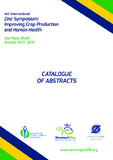| dc.description.abstract | Zinc (Zn) is vital for many biological functions and plays a crucial role in more than 300 enzymes in the human body (Brown & Wuehler 2002). The risk of low dietary intake of absorbable
Zn and consequent deficiency is a widespread problem in Sub-‐Saharan Africa (SSA). In Kenya Zn deficiency occurs in about half of the children, mothers and men; diarrhoea, hookworm and
anaemia are the main risk factors for hypozincaemia among children (Save the Children 2012); anaemia and respiratory tract illnesses are each associated with nearly two-‐fold increase in risk of hypozincaemia among mothers -‐pregnancy further exacerbated the risk of zinc deficiency; while schistosoma infections and Vitamin A deficiency are associated with two-‐fold increase in the risk of hypozincaemia in men (Republic of Kenya 2011). Because of the likely high national prevalence of Zn deficiency and the serious range of complications, sustainable interventions are needed to boost zinc intakes (Ministry of Public Health and Sanitation 2008). As diet is the most important source of Zn, collection of dietary intake data is of primary importance for the
identification, treatment, and management of Zn deficiency disorders. Zn interacts with other elements which are deficient in SSA such as selenium (Se) and therefore analysis of Se will be included in this study (Joy et. al. 2014, Eybl et. al.1999). Therefore, we are currently conducting a cross-‐sectional descriptive survey aimed at assessing the Zn intake and status among the 6-‐59 months old children and their mothers in Kenya. Dietary intake data combined with the Zn content of local foods will institute the actual intake for selected 29 study areas in the agricultural production zones; 21 regions in the central Kenya highlands and 8 regions along the Lake Victoria basin. Food, soil, hair and nail samples will be taken
from the selected households. The association between soil Zn and crop Zn, and between population Zn status and Zn intake will help to determine the soil characteristics that influence soil-‐to-‐plant Zn transfer, and dietary factors that influence Zn status among the population. Past nutrition interventions such as supplementation and food fortification have failed to reach the rural
population. Therefore, it is intended to also conduct Zn, and Se agronomic biofortification trials in a next phase, as a possible solution to the ‘hidden hunger’.Study areas were identified first based on the various soil types used for agriculture in. Kenya. Correlation between Zn in plant and soil can be found if the relationship is investigated within various soils types; the mobility and plant-‐availability of Zn in soil is controlled by a number of soil’s chemical and biochemical processes. The second criteria was based on fish consumption habits since sea foods are one of the best dietary sources of Zn. The target population is 6-‐59 months old children and their mothers because Zn plays an important role in facilitating the folding of proteins into the biologically active molecules used in gene regulation. It is therefore critical for cell replication and normal growth. Zn deficiency depresses growth resulting to stunting an important problem in young children in SSA. Child growth can therefore be used as an evaluation criteria for the impact of interventional measures beside the 93 biochemical markers. Based on a Zn
deficiency proportion of 50% among children in Kenya, 754 subjects are needed for the study. From the randomly selected households in each study area, a composite 100 g soil samples will be collected from the farm, 40g of each food produced for the
farm, 1.5 to 2 g of hair samples and 10-‐50 mg of nail samples depending on availability. All the samples will be transported to Belgium and analysed at the Laboratory of Analytical Chemistry and Applied Ecochemistry, Ghent University. Laboratory results and dietary intake data will be analysed with STATA statistical package. Soil-‐plant and Zn status-‐dietary intake regression models will be derived to determine the relation between Zn concentrations in crops and soil characteristics and the relation between Zn concentration in hair and nail and dietary Zn characteristics (concentration in hair and nail, dietary intake), respectively.
Results.
Samples are currently still being collected in Kenya. Dietary intake data combined with the
Zn concentration of local foods plus soil Zn concentration will reflect the Zn exposure at the
population level. Hair and nail samples will be used to assess Zn status at the individual level. The fact that soil types were included as a selection criterion for the sampling sites allows us to study correlations between Zn concentrations in plant and soil to assess the mobility and plant-‐availability of Zn in the soil, which is controlled by a number of chemical and biochemical processes. The association between soil Zn and crop Zn concentration will help to determine the soil characteristics that influence soil-‐to-‐plant Zn transfer, while the association between population/individual Zn status and Zn intake will help to determine dietary factors that influence Zn status among the target population. Regression models will be used to determine the relationship between Zn concentrations in crops and soil characteristics, and the relationship between Zn concentration in hair/nail and dietary Zn characteristics, respectively. | en_US |

